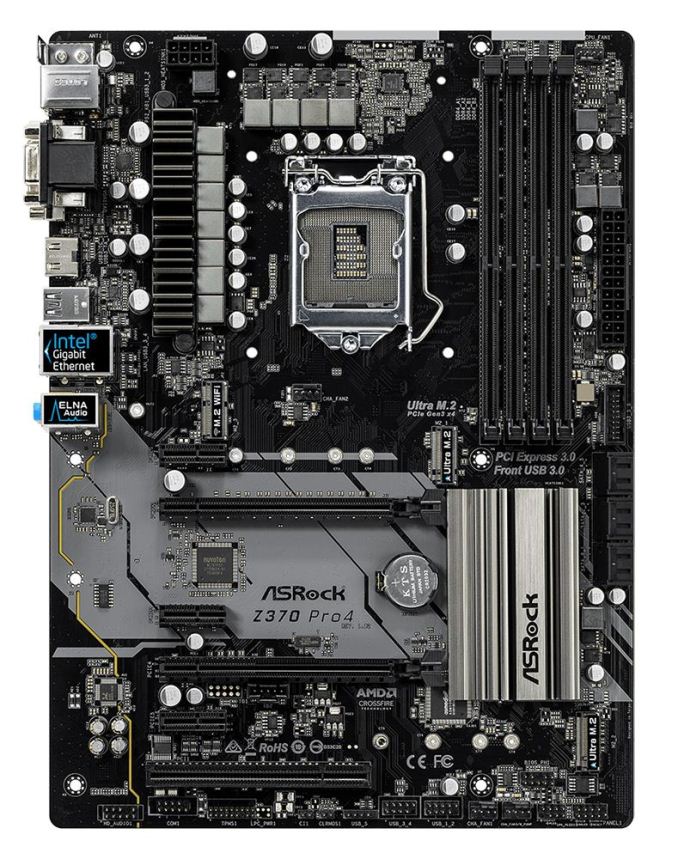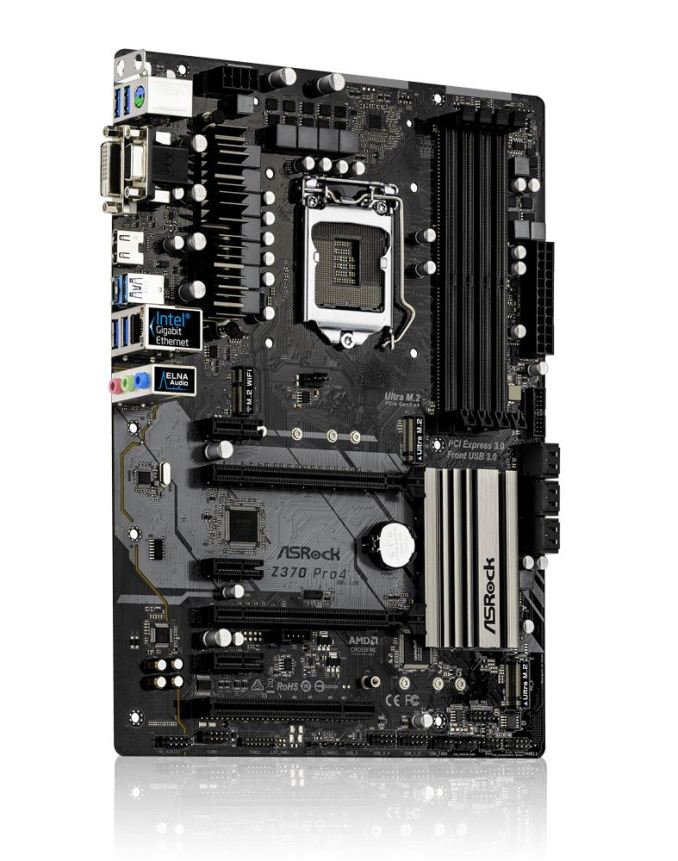Analyzing Z370 for Intel's 8th Generation Coffee Lake: A Quick Look at 50+ Motherboards
by Ian Cutress, Anton Shilov, Joe Shields & Gavin Bonshor on October 20, 2017 2:00 PM ESTASRock Z370 Pro4
The ASRock Z370 Pro4 falls on the lower end of the Z370 lineup and with that, a few of the features we’ve seen on the other boards don’t manage to make their way here. In an effort to shave a few dollars off, the Pro4 uses one VRM heatsink located on top of the left set, while the top set is left without a heatsink. In some cases, particularly when overclocking, this can lead to overheating, although this is more of an entry-level product. The board is free of any slot reinforcement, but has two M.2 slots, but only one of which is PCIe 3.0 x4 and the other supports only SATA based M.2 drives.
The Pro4’s design is predominately black, with a grey print on the PCB starting from the top of the audio section working its way by the PCIe slots through the chipset heatsink to the edge of the board. For the power delivery, the single heatsink and capacitors stick out on the board like drops of water on colored paper. The Pro4 does not look bad, but it is missing any window dressing (shrouds) and RGB LEDs. In fact, no RGB headers can be found on this board. (Ian: Perhaps that is a good thing.)
Even though this is an entry-level ‘Pro’ board, the full 64GB of memory can be used, with speeds up to DDR4-4266 listed as being supported. There are two full-length PCIe slots, but only the first is powered by the processor for x16 connectivity. The second full-length is a PCIe x4 from the chipset, and there are three other PCIe x1 slots also from the chipset. The final slot on the board is a legacy PCI slot. Overall, SLI is not supported, however Crossfire in x16/x4 mode is a possibility.
Storage options include six SATA ports and two M.2 ports. The SATA ports support RAID 0, 1, 5, and 10 and also share connectivity with the M.2 slots. If the first M.2 is occupied by a SATA type device, SATA 5 will be disabled. If the second M.2 slot has a SATA type device, SATA 0 will be disabled. Note only the top M.2 slot supports PCIe 3.0 x4 speeds, while the second M.2 slot is relegated to SATA only duties. For USB there are three USB 2.0 and one USB 3.1 (5 Gbps) headers.
Users will find four 4-pin fan headers on the board, with the Chassis Optional/Water Pump fan connector which can deliver a maximum of 1.5A/18W for water pumps that require extra power. The Realtek ALC892 audio codec is from the last generation and uses ELNA audio caps, and although this is a 7.1 channel audio codec, in order to configure 7.1 channel HD audio, the HD front panel audio is required and enabled through the driver. Networking duties are handled by the Intel I219-V gigabit Ethernet controller.
There is no USB 3.1 (10 Gbps) support here - instead, the back panel IO has five USB 3.1 (5 Gbps) Type-A ports and one Type-C port. On the rest of the back panel, users can find a PS/2 port, D-Sub/DVI-D/HDMI video outputs, and a three-jack audio stack.













83 Comments
View All Comments
weevilone - Wednesday, October 25, 2017 - link
Notable that though the new boards are often very similar to their Z270 predecessors, Asus has dropped Thunderbolt 3 support from the Maximus X Hero board.masouth - Thursday, October 26, 2017 - link
ASUS ROG Z370 Maximus X Hero"....new metallic heat sinks that are an upgrade over the plastic heatsinks found on the Z270 version"
Please excuse my ignorance because I didn't own a ROG Z270 mb but...plastic HEAT SINKS? Not shrouds or decoration over a heat sink but the actual heat sinks themselves? That's either wrong, they performed their job pretty poorly, or plastic resins have advanced a lot farther in thermal conductivity (and cost for such) than I realized.
flowrush - Sunday, November 19, 2017 - link
"The other main distinguishable feature is the inclusion of integrated 802.11ac Wi-Fi with an antenna (that can only be described as a shark fin) found on the F."The above is incorrect in the article. The integrated Wi-Fi module with antenna is found on the E not the F.
Coldgame - Saturday, November 25, 2017 - link
I'm looking to build a rig with the Z370 Gaming ITX/ac, a GTX-1070 card and an Apple Thunderbolt Display.The review states:
"The key difference in the support between the two boards is going to be the Thunderbolt 3 port on the Gaming-ITX. This port supports video outputs..."
So, can anyone confirm or deny that video generated by the GTX-1070 can be output through the onboard Thunderbolt 3 port?
hanselltc - Sunday, December 3, 2017 - link
Looking forward to low-middle end mITX choices from this platform. It'll probably be paired with a 8100/8300 and be my secondary machine.Roen - Sunday, February 4, 2018 - link
Where are the 10 Gbps ports on the back? They all look like 5 Gbps ports, even the Type C.rbarak - Wednesday, February 21, 2018 - link
Is anyone using the Z370-P on Linux with two screens?I built a new machine based on the Z370-P, and both the DVI and the HDMI connected screens show the same image, and the RHEL7 setup/displays show only one Unknown Display.
I follwed the advice on stackexchange, and added this line:
$ grep GRUB_CMDLINE_LINE_DEFAULT /etc/default/grub
GRUB_CMDLINE_LINE_DEFAULT="i915.alpha_support=1"
Then I did:
sudo grub2-mkconfig -o "$(readlink /etc/grub2.conf)"
And rebooted, but still, the two displays are not shown.
dromoxen - Wednesday, May 9, 2018 - link
Shocked to see that both the Asrock mitx boards are "szie=ATX" .. LOLThe addition of Tunderbolt sure seems to add a hefty premium £120 vs £160 , luckily I can do without.
Kroebo - Sunday, October 7, 2018 - link
Sadly, I discovered that the ZUG Gaming PLUS doesn't support SLI.trag - Tuesday, January 15, 2019 - link
On the ASrock Z370M Pro4 the M.2 slot information is backwards. Both slots support NVME. One slot also supports SATA. As written, "The first M.2 slot is SATA only while the second supports PCIe." it seems to say that one slot is SATA only and the other slot is PCIe (NVME) only.